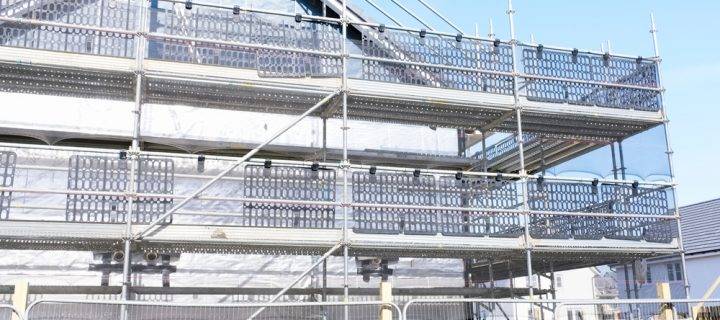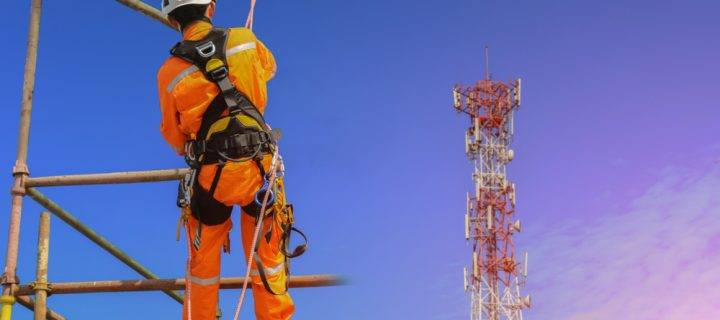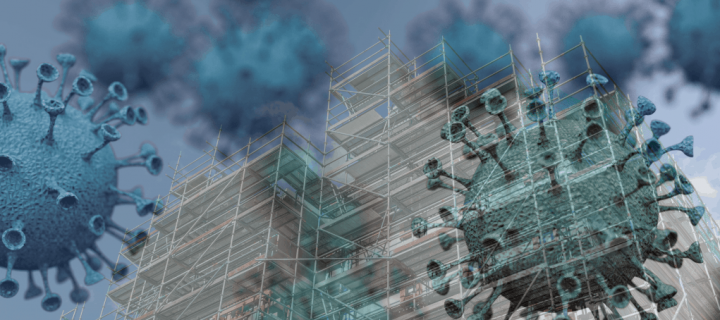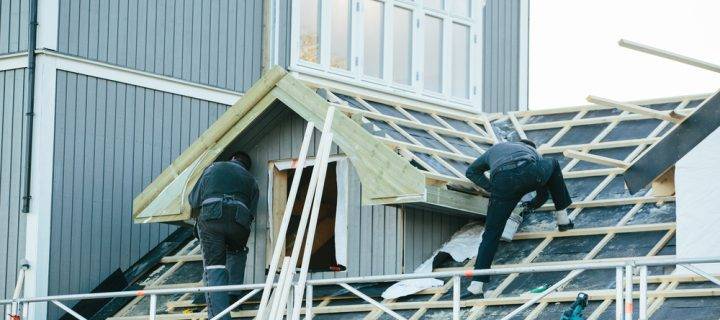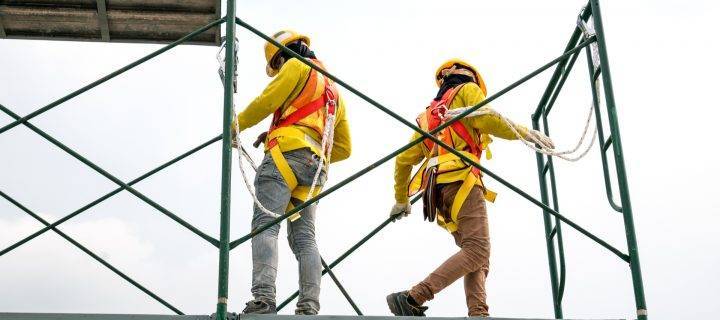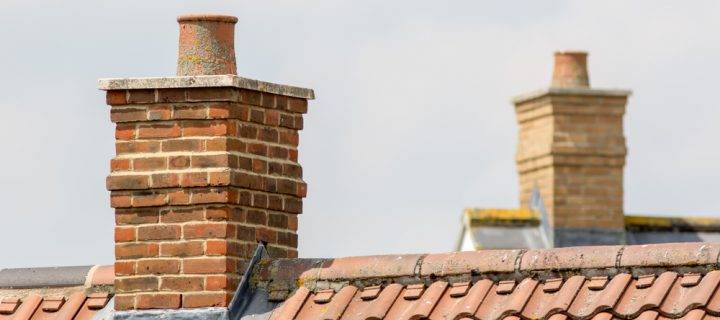In the wake of the COVOD-19 pandemic, new guidelines have been released from the Scaffolding Association regarding risk assessments and site inspections. As an associated member of the Scaffolding Association, Network Scaffold are adhering to new measures put in place to maintain social distancing and keep our workforce and the general public safe. The Importance of Risk Assessments A risk assessment is a key element to determining the frequency of periodic inspections and identifying scaffolds that may be at most risk from adverse weather. Here are some points that should be considered for risk assessments on low risk and high-risk sites – Low-Risk Sites This type of site is usually self-contained with a low risk of the scaffold structure being compromised or components falling outside of the site boundary. Examples include – Site using scaffold that is less than 10 metres in height Sites with fencing or hoarding where the scaffold is not adjacent to the boundary A commercial site where the business operations have ceased High-Risk Sites This type of site will be situated in the public domain, or are self-contained with the scaffold structure at high risk of being compromised or components falling outside of the site boundary. Here are four examples to note – Sites with scaffold over 10 metres in height A site using sheeted scaffolds or temporary roofs Sites adjacent to highways, transport areas or utilities A commercial site where the business operations continue to function How to Undertake Scaffolding Inspections The Government is currently advising that people, except for essential workers, to stay at home because of the direct risk to life from COVOD-19. Where undertaking an inspection is necessary, guidelines should be considered and implemented. Before attending site for inspections, you will need to have the following in place – The correct contact details of the Client or Principal Contractor Arrangements for gaining safe access to the site Suitable lone working procedures for the Scaffold Inspector COVOD-19 risk assessment for the Scaffold Inspector COVOD-19 risk assessment for any individuals required to carry out necessary remedial works Want to Know More? Contact Us Today If you have any more questions about scaffolding services provided by Network Scaffold, please get in touch...
Read Moreabout Guidance for Scaffold Inspections and Risk AssessmentsThe Coronavirus has had a significant impact on businesses, affecting operations, supply chains, customer engagement and service. Here at Network Scaffold, we understand the challenges this has created in the scaffolding sector, with regards to protecting workers and the general public. Recently the Scaffolding Association has released guidelines to help scaffolding firms handle this tricky situation, whilst continuing to provide a vital service to clients. For our latest blog, we are going to focus on the guidance for on-site workers plus the necessary PPE equipment that will be made available. Coronavirus – Working Onsite for Scaffolders The health and safety requirements must not be compromised and if the scaffolding task cannot be undertaken safely then it should not take place. According to the Scaffolding Association, the following measures should be considered when employees are undertaking necessary work onsite – Planning work to minimise contact with other site users, which could include altering shift patterns or restricting access to work areas. Complying with social distancing measures and keeping 2 metres apart. While working on scaffolding this would equate to being approximately one bay apart vertically or every other life horizontally. Using stairs in preference to lifts Use your own tools and equipment Canteens will not be operating as normal, with breaks staggered with employees bringing their own prepared meals and drinks whilst adhering to social distancing measures. Soap and water should be easily accessible and where not possible, hand sanitiser. Sufficient waste bins for handtowels, which should be regularly removed and disposed of. Keeping a sufficient supply of additional soap, hand sanitiser and paper towels Personal Protective Equipment Onsite Guidelines When Personal Protective Equipment is provided for employees, the following measures need to be implemented – Gloves should be considered a minimum precaution Where RPE (Respiratory Protective Equipment) is prescribed the user should have this face fit tested Re-usable PPE requires a thorough clean after use and must not be shared with other workers Single-use PPE should be disposed of to ensure it is not reused Got any Questions? Get in Touch If you have any questions about our scaffolding services, please contact Network Scaffold...
Read Moreabout Coronavirus Guidelines for Scaffolding Firms ExplainedAs the Coronavirus continues to spread all over the world, we need to look at how it could potentially impact the scaffolding sector. There have been thousands of cases reported worldwide, with 596 cases confirmed in the UK at the time of writing this post. Although drastic measures such as closing schools, cancelling events, banning large public gatherings and working from home have been mentioned – this simply isn’t possible within the scaffolding and wider construction industry. Reports have suggested that up to 80% of workers could be unable to work during the forthcoming weeks of the outbreak. Evidence has shown the COVID-19 virus is already present in the industry after EDF reported that one of its workers on Hinckley Point C where two nuclear reactors are being built, has contracted Coronavirus. The latest advice from the UK Government is that workers with symptoms of COVOD-19 are advised to self-isolate for two weeks. The Impact on the Supply Chain Supply chains could be impacted with some scaffolding materials like tube and fittings imported by some providers, from the virus’ country of origin – China. For Network Scaffold, and its employees it is very much business as usual unless we communicate otherwise. Advice on Avoiding Coronavirus The NHS has suggested the following measures to avoid catching and spreading coronavirus – • Wash your hands with soap and water often – do this for at least 20 seconds. • Always wash your hands when you get home or into work. • Use hand sanitiser gel if soap and water are not available • Cover your mouth and nose with a tissue or your sleeve (not your hands) when you cough or sneeze. • Put used tissues in the bin straight away and wash your hands afterwards. • Try to avoid close contact with people who are unwell. • Do not touch your eyes, nose or mouth if your hands are not clean. Contact Us for More Information If you have any questions about our scaffolding services, please get in touch today. Network Scaffold offer scaffolding, access scaffolding, edge protection and alloy towers for projects right across Derbyshire and the surrounding...
Read Moreabout The Impact of Coronavirus on the Scaffolding IndustryReplacing tiles, repairing cracks and structural jobs are all complex tasks for carrying out roof repairs. Network Scaffold would always recommend you work with a qualified roofing professional, as they all have several risks for both access and safety that you need to be aware of. The important question is – do you need scaffold or a ladder for roof repairs? Scaffolding will cost you more, but can put a price on safety? What you get with scaffolding from Network Scaffold, is high-quality scaffold from accredited professionals who are members of the Scaffolding Association. Below we are going to provide the necessary guidelines for your next project to help to make an informed decision. What Size is the Project and How Can Scaffolding Help? For smaller projects, such as a minor gutter repair or fallen roof tile towards the edge of the roof that only needs one of two people – you will be okay using a ladder. However, for larger repairs such as laying new roof tiles across your whole roof requires a proper risk assessment report – meaning you need scaffolding. Jobs that require work on your entire roof are also going to need scaffold, as it gives those carrying out repairs a safe and sturdy platform to stand on and carry out the work more efficiently than going up and down a ladder every few seconds. For workers on the ground, scaffolding is also safer, as if the scaffold is fitted with edge protection it will alleviate the risk of materials falling and causing injuries. Chutes can also be installed to allow the safe transportation of materials. How Long Could Your Project Take? If your project takes longer than a day, using scaffold is always the best option, as it is more efficient plus the fact the elements can take their toll over a number of days. Scaffolding is much more robust in harsher conditions compared to a ladder. With the recent Storm David, Storm Ciara and Storm Jorge reinforcing this point. Want to Know More about Scaffolding? Contact Us Today If you want to know more about scaffolding for commercial and domestic projects, please get in touch with Network Scaffold...
Read Moreabout Roofing Repairs using ScaffoldingHere at Network Scaffold, we understand the importance of providing the safest scaffolding for both commercial and domestic projects. For our latest blog, we are going to explain the legal requirements, competence and supervision guidelines for scaffolding. All scaffolds must be erected, altered and dismantled in a safe manner, which is achieved by referring to guidelines provided by the National Access & Scaffolding Confederation (NASC) in a document called SG4: Preventing Falls in Scaffolding. Contractors need to follow similar guidance provided by the manufacturers of their scaffolding system (such as Network Scaffold) or by consulting Access Design & Safety literature on Design Safe. Contractors need to be aware that any proposed alterations or modifications which takes scaffold outside of a generally recognised TG20 configuration must be designed, checked and proven via calculations by a competent person. What Should Scaffold Design Include? Work at Height Regulations 2005 state that unless scaffolding is assembled to a recognised configuration and must be designed by a competent person with bespoke calculation. This ensures the scaffold will have required rigidity, strength and stability during the erection, use and dismantling. Competence and Supervision Guidelines for Scaffold Employees must be competent for scaffolding work they undertake and receive sufficient training which is relevant to the complexity of the scaffolding they are working with. At the minimum, each member of your scaffolding team needs to contain a competent person who has the appropriate level of training needed for the scaffold they are working with, that covers how to erect, alter and dismantle the scaffold. Trainee and apprentice scaffolders should always be directly supervised by a competent person. Any operative who has yet to complete approved training methods and assessment should be considered trainees. Want to Know More? Get in Touch If you have any more questions about our services, please contact us today. Network Scaffold is the leading suppliers of scaffold and access scaffold across the East Midlands – including Derby and...
Read Moreabout Understanding the Legal Requirements of ScaffoldingOne of the best ways to create more floor space in an older property is to remove obsolete chimney breast on the ground floor. Here at Network Scaffold, we specialise in helping to improve both commercial and domestic properties with our scaffolding and access scaffolding. For our latest post, we are going to share some handy tips to remember when having a chimney removed. Following Industry Guidelines Quite often chimneys are removed at first-floor level which leaves just the roof void and the external section of the chimney in place. Building Regulations do apply to this work as it is a ‘material alteration’ to the structure which ensures the remaining part of the stack is sufficiently supported. When the whole chimney is removed you will need some professional advice (from specialists such as Network Scaffold) to determine the structural implications; plus you may require planning permission for its removal. Extra care is required where this project falls into works covered under the Party Wall etc. Act 1996 with notice needing to be served on any adjacent property. This is so shared flues and structural adequacy can be put under consideration before work begins. 6 Things You Need to Consider When Removing a Chimney 1. Bracket members need to be 75mm x 75mm x 6mm mild steel angles with 6mm fillet shop welded joints with the angles being pre-drilled to take a minimum of 2no M12 chemical or resin anchor bolts. 2. Bolts need to be drilled into sound brickwork and not mortar joints, with the condition of the brickwork critical. 3. A plate (10mm steel plate, for example) needs to be placed on top of the brackets which prevents soot and debris from falling from the remaining chimney. 4. The minimum height of the remained chimney breast below needs to be equal to or greater than the height of brickwork above the roofline. 5. To make sure any rain or condensation that passes into the flue will dry out by natural convection; the chimney pot needs to be capped with a ventilated cowl with an air brick inserted at a lower level. 6. Fireplace hearths on the ground or first-floor level need to be removed with additional timber joints...
Read Moreabout How to Safely Remove Chimneys from Properties
